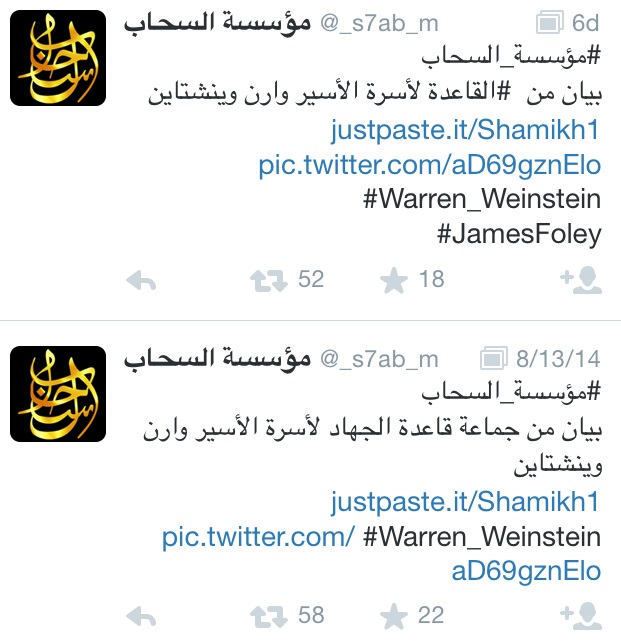TWEE-HAD: IMPLICATIONS OF THE GLOBAL JIHAD POPULARITY CONTEST
TWEE-HAD: IMPLICATIONS OF THE GLOBAL JIHAD POPULARITY CONTEST
By Michael S. Smith II
For nearly two months, the Islamic State has been jockeying for control over the Global Jihad movement. In recent days, signs have emerged that the group’s strategy for winning the popularity contest underway between it and al-Qa’ida will entail convincing jihadis of the group’s capabilities to terrorize Americans. The implications of this strategy are tremendous for US interests, but, in terms of their immediacy, perhaps even greater for an American held hostage by al-Qa’ida. US national security managers would be wise to consider the larger implications of this situation before hastily making more misadvised statements regarding which group — the Islamic State, or al-Qa’ida — poses the greatest threat to Americans. For the declaration that one of these elements poses a greater threat to the US than the other could be tantamount to throwing fuel on a fire.
On 13 August 2014, al-Qa’ida’s official media wing, as-Sahab, tweeted a link to a message addressed to the family of “the prisoner” Warren Weinstein, an American whom al-Qa’ida claims to have been holding hostage since he was kidnapped in Pakistan on 13 August 2011. Several days later, a video showcasing the beheading of American journalist James Foley by an English-speaking jihadi affiliated with the Islamic State appeared online, and was promoted by social media accounts managed by individuals affiliated with the Islamic State. Within hours, as-Sahab’s Twitter account posted another message highlighting al-Qa’ida’s recent message to the Weinstein family — this time with reference to terrorism victim “#JamesFoley” (screenshot above).
For decades, terrorists have exploited news media to propagate their messages on a global scale. Offering greater communications controls than news reports which might not present a group’s entire message, or might offer shoddy analysis of a group’s agenda, in recent years social media platforms like Twitter, YouTube and Facebook have become key instruments in the terrorist’s propaganda toolkit. Today, these tools are of immeasurable value to the Islamic State as it works to distinguish itself from al-Qa’ida while at the same time attracting support from jihadist elements the world over that are sympathetic to al-Qa’ida. Thus how the Islamic State uses these tools reveals a great deal about the group’s strategy for asserting control over the Global Jihad movement.
It is unclear if the murder of James Foley was sanctioned by the Islamic State’s senior leaders. It is also unclear the extents to which the group’s leaders are able to assert control over foreign fighters like the one who murdered Foley.
Nevertheless, as Islamic State leaders have not repudiated the act, they apparently view the video featuring the murder of James Foley as a tool of strategic value.
Inasmuch as it served as a response to recent US military efforts to roll back the Islamic State’s territorial gains in Iraq, the video served to bolster outreach to prospective recruits and supporters in the West. Concomitantly, efforts to extort more than $100 Million from the Foley family and the US government undertaken by James Foley’s captors, coupled with the spectacle of the execution of the American hostage used in those efforts demonstrate the sincerity of the Islamic State’s anti-US posturing.
By matching deeds with the leadership’s rhetoric, via this video, the Islamic State has provided jihadis the world over further evidence of its commitment to the global jihadist cause. Moreover, by successfully eliciting a response from Washington that entails escalation of the United States’ efforts to degrade threats posed by the group, this propaganda will almost certainly also have the effect of inspiring more jihadist groups to pledge allegiance to the Islamic State’s leader.
While the group’s promotion of the video featuring the murder of James Foley constitutes but one more example of the group’s extraordinary efforts to overshadow the specter of al-Qa’ida, an important question is: Given that it appeared online soon after al-Qa’ida called attention to its American hostage, does the Islamic State’s circulation of this video demonstrate a responsiveness to al-Qa’ida’s propaganda on the parts of the Islamic State’s strategists who are almost certainly seeking ways to trump the impact of that propaganda?
Interestingly, using the hash-tagging technique on Twitter, it appears al-Qa’ida is trying to piggyback on the attention the Islamic State has cultivated for its grotesque propaganda by converting interest in the execution of James Foley into a tool to promote al-Qa’ida’s own activities.
Indeed, by plugging Foley’s execution in this manner, al-Qa’ida is attempting to steer audiences searching for information about the Foley murder on Twitter to posts that highlight al-Qa’ida’s own ongoing efforts to coerce the US government. Such efforts are being undertaken in a public manner in order to highlight al-Qa’ida’s ongoing anti-US pursuits at a time when most of its operatives are apparently more focused on striking proximate “apostate” governments than attacking the West, despite al-Zawahiri’s assertion the US and Israel remain al-Qa’ida’s chief targets.
Also unclear is the matter of whether as-Sahab’s Twitter post featuring Foley’s name constitutes more than an effort to exploit the attention garnered by its new rival. Indeed, was this a signal of plans to execute its own American hostage?
If so, that signal has not had the effect of reorienting popular interest away from the Islamic State, and back toward al-Qa’ida. Therefore, taking into consideration the level of attention the Islamic State has garnered by executing an American hostage, it should not be ruled out that al-Qa’ida senior leaders are contemplating doing the same in order to generate a spectacle that could eclipse that of the Islamic State’s latest play.
As the Islamic State ups the ante, it is reasonable to anticipate al-Qa’ida might do the same in order to demonstrate its continued leadership in the Global Jihad movement’s efforts to cause harm to the US and its allies. Meanwhile, the growing volume of erroneous claims made by US officials that characterize the Islamic State as a greater threat than al-Qa’ida could serve to lead al-Qa’ida to work harder to prove America’s top national security managers still do not understand the threat environment before them.
While the Islamic State is likely capable, and many of its members and supporters are almost certainly intent upon executing attacks in the US, al-Qa’ida began building a network capable of conducting such strikes more than a decade before the group now known as the Islamic State existed. And while the Islamic State’s operatives, or the group’s supporters might try to eclipse the specter of al-Qa’ida’s 9/11 attacks of 2001 with their own strikes in the West, it is far more likely that, if its senior leaders are inclined to encounter the blowback from doing so, al-Qa’ida could more easily do the same. Indeed, while intent is an important factor to consider when assessing threats posed by terrorist elements, intent paired with proven capabilities should constitute a more pressing set of concerns — especially at a time when a competition for influence over the Global Jihad movement is underway, and, for the contenders, the spectacle of carnage is a key form of currency.




